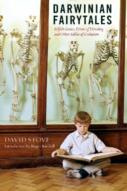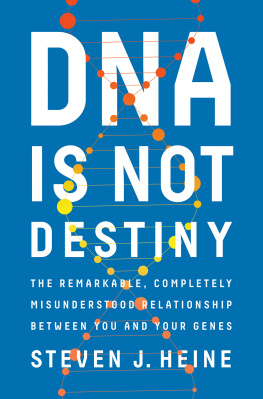Steven Potter - Designer Genes: A New Era in the Evolution of Man
Here you can read online Steven Potter - Designer Genes: A New Era in the Evolution of Man full text of the book (entire story) in english for free. Download pdf and epub, get meaning, cover and reviews about this ebook. year: 2010, publisher: Random House, genre: Romance novel. Description of the work, (preface) as well as reviews are available. Best literature library LitArk.com created for fans of good reading and offers a wide selection of genres:
Romance novel
Science fiction
Adventure
Detective
Science
History
Home and family
Prose
Art
Politics
Computer
Non-fiction
Religion
Business
Children
Humor
Choose a favorite category and find really read worthwhile books. Enjoy immersion in the world of imagination, feel the emotions of the characters or learn something new for yourself, make an fascinating discovery.
- Book:Designer Genes: A New Era in the Evolution of Man
- Author:
- Publisher:Random House
- Genre:
- Year:2010
- Rating:4 / 5
- Favourites:Add to favourites
- Your mark:
- 80
- 1
- 2
- 3
- 4
- 5
Designer Genes: A New Era in the Evolution of Man: summary, description and annotation
We offer to read an annotation, description, summary or preface (depends on what the author of the book "Designer Genes: A New Era in the Evolution of Man" wrote himself). If you haven't found the necessary information about the book — write in the comments, we will try to find it.
Designer Genes: A New Era in the Evolution of Man — read online for free the complete book (whole text) full work
Below is the text of the book, divided by pages. System saving the place of the last page read, allows you to conveniently read the book "Designer Genes: A New Era in the Evolution of Man" online for free, without having to search again every time where you left off. Put a bookmark, and you can go to the page where you finished reading at any time.
Font size:
Interval:
Bookmark:

Copyright 2010 by Steven Potter
All rights reserved.
Published in the United States by Random House, an imprint of The Random House Publishing Group, a division of Random House, Inc., New York.
R ANDOM H OUSE and colophon are registered trademarks of Random House, Inc.
Library of Congress Cataloging-in-Publication Data
Potter, Steven.
Designer genes: a new era in the evolution of man/Steven Potter.
p. cm.
eISBN: 978-1-58836-998-7
1. GenesPopular works. 2. Human geneticsPopular works. 3. Genetic engineeringPopular works. I. Title.
QH447.P68 2010
611.01816dc22 2009041659
www.atrandom.com
Diagrams by Jan Warren
v3.1
To Stan, Leora, and Sue, for their support,
to my agent, Peter Riva, for championing my cause,
and to my editor, Bob Loomis, for his unending patience and insight
Where did we come from? Where are we going? What did people look like in the past, and could they change in the future? These are questions that naturally pique our curiosity.
In searching for the answers we can examine the fossils from the earth. The first fossil record of the human lineage, separated from the apes, was found shortly after Darwins death. This preman was named Homo erectus and lived over a million years ago. During the past century more than a thousand additional fossilized bones of human ancestors have been found, revealing a slow progression during the past seven million years to what people are today. In particular the skulls show a dramatic increase in size that started about two million years ago, eventually resulting in a tripling of the mass of the brain, from about one pound up to the current three. Instead of exceptional strength or speed this new creature seemed to rely on a vastly superior intelligence for survival. While the fossil record remains incomplete, the buried bones lead us to the inescapable conclusion that the ancestors of humans looked quite apelike, and very different from what we are today.
To better understand our past we can also look at the historical archive of our DNA, the substance of our genes. We have learned that DNA is not immutable, but rather it also changes slowly with time. It is a molecular clock. One can study the relationships of the various forms of life on our planet by examining their DNA sequences. It turns out that there is a very striking commonality in the genetic endowment of the various species. We all have surprisingly similar sets of genes. Everything seems related to everything, to some degree. Even the lowly fruit fly has some genes that are extremely similar to their counterparts in humans. Indeed, in a few cases it has been possible to swap a human gene into the fly, where it functions just fine. The fly doesnt seem to mind. And when one compares the DNA sequences of more closely related species the similarities absolutely overwhelm the differences. For example, the DNA of the human and the chimpanzee is approximately 99 percent identical. The molecular clock therefore agrees with the fossil record, indicating a close relationship between apes and man, and telling of the existence of a common ancestor millions of years in the past.
Evolution is very slow. Within the life span of a person evolution is practically invisible. There is nothing to see. It generally takes hundreds of thousands, or millions, of years for major changes to take place. The genius of Darwin was to recognize that even extremely small modifications that occur during a single generation can accumulate over long periods of time to give important consequences. Darwin noted in his book On the Origin of Species, As many more individuals of each species are born than can possibly survive; and as, consequently, there is a frequently recurring struggle for existence, it follows that any being, if it vary however slightly in any manner profitable to itself, under the complex and sometimes varying conditions of life, will have a better chance of surviving, and thus be naturally selected (italics added). Today we often summarize this statement as the survival of the fittest. But Darwins theory of evolution requires more. Not only must the fittest survive, but they must also pass their better qualities to their offspring. At around this same time the Austrian monk Gregor Mendel published a paper, Experiments in Plant Hybridization, describing the transmissible nature of characters, such as flower color and stem length, in the garden pea. Although Darwin was unaware of Mendels work he fully appreciated the heritable nature of traits. He stated, From the strong principle of inheritance, any selected variety will tend to propagate its new and modified form. So the fittest will survive, and their offspring will also be more fit. And the cheetah keeps getting faster, to capture more prey, and the giraffe keeps getting a longer neck, to reach more vegetation.
While humanitys past is a series of facts, with some known and some waiting to be discovered, our future is more a matter of conjecture, and controversy. Some argue that the technology of civilization has removed the selective pressures of the past and that people have therefore stopped evolving. Others suggest that some selective survival and procreation do indeed remain today and that humans continue to evolve, albeit at a snails pace. Yet another view is that we are about to enter a new era, where all of the forces that drive our evolution are about to change.
THE TRUE STORY OF ADAM
B oth Lisa and Jack Nash were carriers for a Fanconi anemia gene mutation. They didnt know it, because they were quite healthy, but they both had one good and one bad (nonfunctional) copy of this gene. Their first child, Molly, unfortunately received two bad copies of the gene, one from each parent. As a result, she had Fanconi anemia, which is a disease with several manifestations, but the most lethal is a blood disorder: the body fails to produce enough blood cells.
Molly was born on July 4, 1994, and it was clear from the outset that things werent right. As Lisa held her newborn daughter in her arms she knew there was a problem. Instead of a forceful cry there was but a whimper. And her thumbs were missing! Lisa quickly asked for a copy of a book, David Smiths Recognizable Patterns of Human Malformation. She had worked for years in a hospital as a nurse for newborns and knew that this was the standard reference book for birth defects. It lists diseases according to symptoms. Using this book Lisa was the first to diagnose her daughter with the very rare Fanconi anemia. Molly suffered from a severe case that would end her life in a few years unless a transplant could be performed. Donor bone marrow from an adult or an umbilical cord from a newborn would have blood stem cells capable of restoring her ability to make blood. But the donor cells must be well matched to those of Molly. Otherwise the donor cells would probably recognize Mollys cells as foreign, like bacteria, and launch a lethal rejection of her body. The transplanted blood cells, meant to save her, would then actually kill her. And despite an extensive search no compatible donor could be found.
Desperate to save their daughter, Lisa and Jack considered their options. If they risked going ahead with a bone-marrow transplant from a nonrelative donor that wasnt well matched, the chances of success were slim, below one in five. Doing nothing would result in Mollys certain death. At this point there didnt seem to be any other options. But then, as they thought more, they decided perhaps there was another choice. If they had another child, they might be lucky, and it might not suffer from Fanconi anemia (only 25 percent of their children would be unfortunate enough to receive two bad copies of the gene). But the odds were still poor that any additional child would provide a compatible transplant match for Molly.
Font size:
Interval:
Bookmark:
Similar books «Designer Genes: A New Era in the Evolution of Man»
Look at similar books to Designer Genes: A New Era in the Evolution of Man. We have selected literature similar in name and meaning in the hope of providing readers with more options to find new, interesting, not yet read works.
Discussion, reviews of the book Designer Genes: A New Era in the Evolution of Man and just readers' own opinions. Leave your comments, write what you think about the work, its meaning or the main characters. Specify what exactly you liked and what you didn't like, and why you think so.











